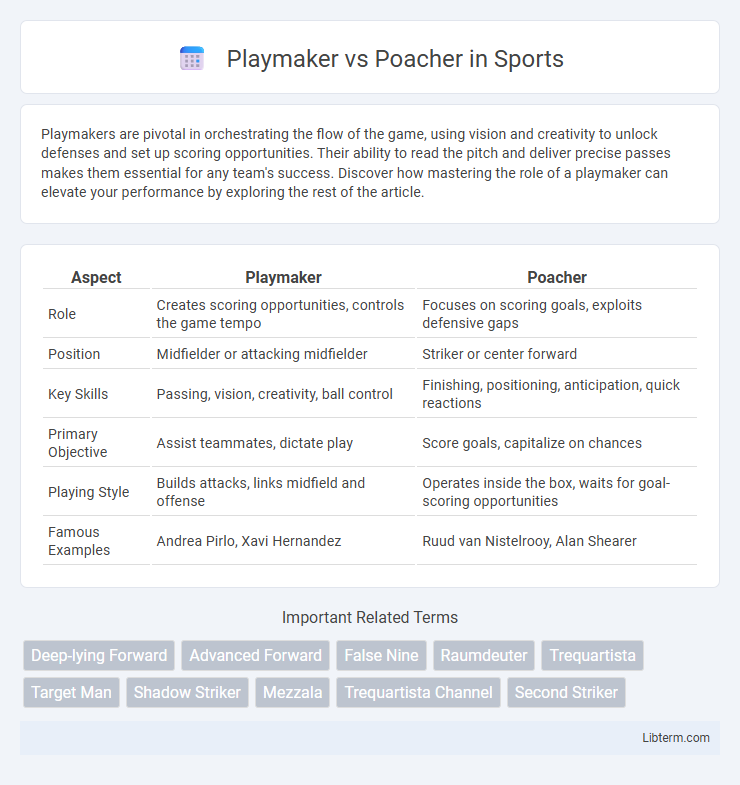Playmakers are pivotal in orchestrating the flow of the game, using vision and creativity to unlock defenses and set up scoring opportunities. Their ability to read the pitch and deliver precise passes makes them essential for any team's success. Discover how mastering the role of a playmaker can elevate your performance by exploring the rest of the article.
Table of Comparison
| Aspect | Playmaker | Poacher |
|---|---|---|
| Role | Creates scoring opportunities, controls the game tempo | Focuses on scoring goals, exploits defensive gaps |
| Position | Midfielder or attacking midfielder | Striker or center forward |
| Key Skills | Passing, vision, creativity, ball control | Finishing, positioning, anticipation, quick reactions |
| Primary Objective | Assist teammates, dictate play | Score goals, capitalize on chances |
| Playing Style | Builds attacks, links midfield and offense | Operates inside the box, waits for goal-scoring opportunities |
| Famous Examples | Andrea Pirlo, Xavi Hernandez | Ruud van Nistelrooy, Alan Shearer |
Introduction: Defining Playmaker and Poacher
A Playmaker is a creative footballer who orchestrates the game by controlling tempo and delivering precise passes that unlock defenses, often positioned centrally in midfield. In contrast, a Poacher is a forward known for exceptional goal-scoring instincts, exploiting spaces inside the penalty area to capitalize on scoring opportunities. Understanding the distinct roles and skill sets of Playmakers and Poachers highlights their critical but differing contributions to a football team's offensive strategy.
Key Roles on the Pitch
The playmaker orchestrates the game by controlling tempo and distributing precise passes to unlock defenses, often operating in advanced midfield positions. The poacher specializes in goal-scoring by exploiting spaces in the opposition's penalty area, capitalizing on quick reactions and positioning. Both roles are vital; the playmaker creates opportunities, while the poacher finishes chances, defining offensive dynamics on the pitch.
Core Skills and Attributes
Playmakers excel in vision, passing accuracy, and creativity, orchestrating attacks with precise through balls and intelligent positioning. Poachers rely on sharp finishing, anticipation, and off-the-ball movement to capitalize on scoring opportunities inside the penalty box. Both roles demand high spatial awareness, but playmakers prioritize playmaking skills while poachers specialize in lethal goal-scoring instincts.
Tactical Importance in Modern Football
Playmakers orchestrate attacks by controlling the game's tempo and delivering precise passes, making them vital for creating goal-scoring opportunities in modern football. Poachers excel in positional awareness and quick reactions inside the penalty area, capitalizing on rebounds and loose balls to convert chances into goals efficiently. Tactical setups often rely on the synergy between a playmaker's vision and a poacher's clinical finishing to maximize offensive effectiveness.
Movement and Positioning
Playmakers excel in creating space through intelligent movement, frequently dropping deep or drifting wide to link play and dictate tempo, while poachers specialize in sharp, instinctive positioning inside the penalty area, capitalizing on quick reactions and opportunistic runs. Playmakers' movement often involves scanning the field and repositioning to exploit gaps in midfield, whereas poachers concentrate on timing their runs to stay onside and anticipate defensive errors for scoring chances. Effective positioning differentiates playmakers' vision-based influence from poachers' goal-focused predatory instincts within the attacking third.
Contribution to Team Offense
A playmaker drives team offense by creating scoring opportunities through precise passing, vision, and controlling the game's tempo, often leading to assists and key plays. Poachers specialize in exploiting defensive gaps to score goals, capitalizing on rebounds and close-range chances with exceptional positioning and finishing skills. Both roles are vital, with playmakers orchestrating attacks and poachers converting chances into points, maximizing overall team offensive output.
Notable Playmakers in Football History
Notable playmakers in football history include legends like Diego Maradona, whose vision and creativity shaped Argentina's attacking style, and Andrea Pirlo, renowned for his precise passing and control in midfield. Xavi Hernandez and Zinedine Zidane also stand out for their ability to orchestrate play and unlock defenses with strategic ball distribution. These playmakers differed from poachers, who primarily focus on goal-scoring opportunities inside the penalty area rather than dictating the game's tempo and setting up teammates.
Legendary Poachers and Their Impact
Legendary poachers such as Gerd Muller and Alan Shearer revolutionized the striker role with exceptional goal-scoring instincts and positioning. Their ability to exploit defensive gaps and convert minimal opportunities into decisive goals defined their teams' offensive strategies. The impact of legendary poachers is evident in their record-breaking goal tallies and enduring influence on striker development worldwide.
Choosing Between Playmaker and Poacher
Choosing between a playmaker and a poacher depends on your team's tactical approach and offensive needs; playmakers excel in creating scoring opportunities through precise passing and vision, while poachers specialize in finishing chances inside the penalty area with clinical precision. Teams prioritizing possession-based football benefit from a playmaker's ability to control tempo and unlock defenses, whereas counter-attacking or direct styles favor a poacher who capitalizes on rebounds and loose balls. Evaluating player attributes such as creativity, positioning, and composure helps determine which role enhances your squad's attacking effectiveness.
Future Trends in Attacking Roles
Emerging future trends in attacking roles highlight a blend of playmaker creativity and poacher efficiency, with advanced analytics driving tailored positioning for optimal goal-scoring opportunities. Tactical evolution emphasizes versatile forwards capable of both orchestrating play and finishing chances, supported by AI-powered performance tracking and real-time decision-making tools. Clubs increasingly adopt hybrid attacking roles combining vision and precision, expanding strategic versatility in competitive football.
Playmaker Infographic

 libterm.com
libterm.com